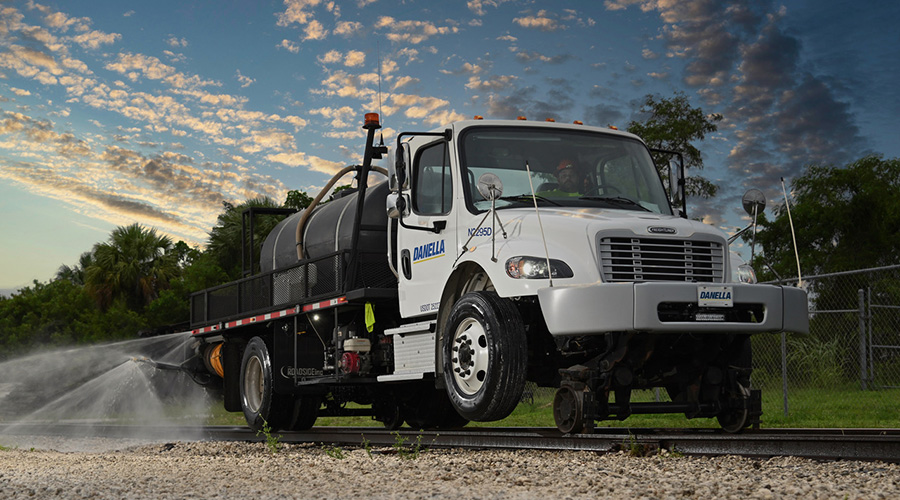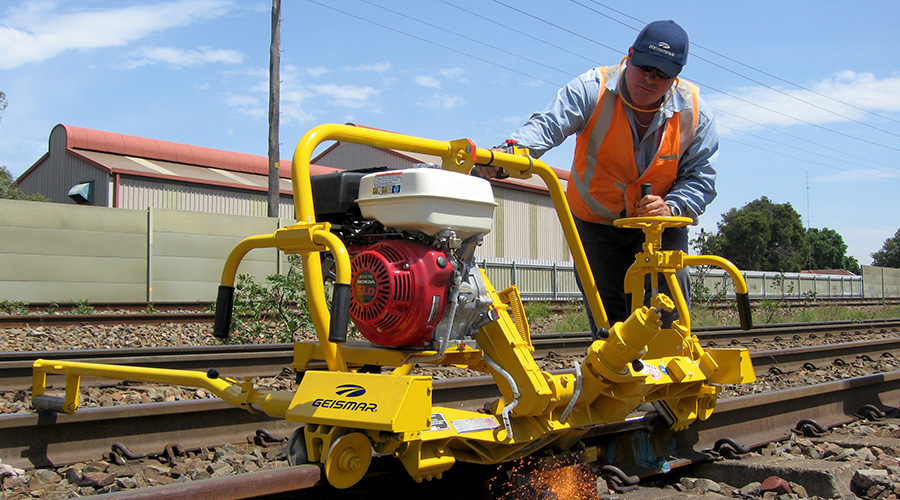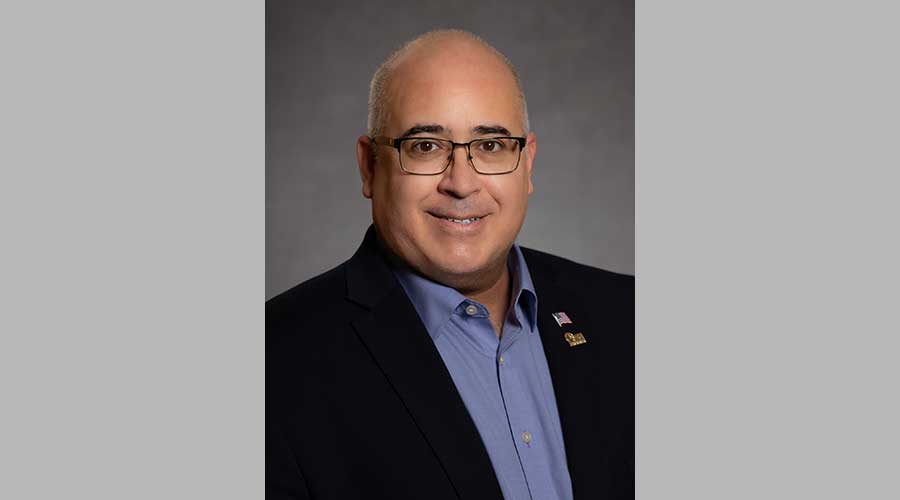Stay updated on news, articles and information for the rail industry
February 2009
Rail News: MOW
Railroads Rely on Different Vegetation-Mangement Techniques, Equipment to Wipe Out Weeds and Take Out Brush
By Jeff Stagl, managing editor
The Southeastern Pennsylvania Transportation Authority (SEPTA) hasn’t changed its vegetation-management approach much the past few years.
The passenger railroad employs several contractors to spray weeds and cut brush to keep rights of way clear from overgrowing foliage.
SEPTA hasn’t significantly altered the herbicides it specifies for weed control each year, either.
But spraying the same chemicals year after year is not an ideal way to prevent herbicide-resistant weeds, such as koshia, Russian thistle and marestail — the biggest challenge facing railroads and their ultimate goal of eradicating vegetation down to bare ground.
“Some railroads use the same herbicides over and over and over, and that creates a monster,” says Homer Deckard, a railroad vegetation management specialist the past 26 years with Dow AgroSciences L.L.C., which supplies herbicides to the rail industry. “I suggest railroads use an herbicide for a couple of years, and then completely change the chemistry every third year to take out weeds that are starting to get resistant.”
However, there aren’t many herbicides on the market for rail applications. The products cost tens or hundreds of millions of dollars to develop, and usually are designed for the agricultural industry — the largest herbicide user — then adapted for the rail industry, says Deckard.
So, many railroads and their contractors now are using three-, four- and five-way herbicide mixes to eradicate hardy weeds instead of two-way mixes that’ve been common for years, he says.
To kill off or control pesky vegetation, railroads also are analyzing different techniques and equipment, or employing new approaches and machinery. They’re attempting to step up their vegetation-control programs, which typically take a three-pronged approach: spraying weeds and cutting brush along track, cutting and maintaining brush off track, and managing vegetation at grade crossings. Some railroads are making try-something-different strides in one, two or all three of the areas.
A chemical reaction
The Alaska Railroad Corp. (ARRC) expects to reap weed-control benefits along track and at crossings from an herbicide research project launched last year with the University of Alaska Fairbanks (UAF).
The freight and passenger railroad hasn’t used herbicides since 1983 because of strict state environmental regulations. Over the years, Alaska officials have denied several attempts by the state-owned railroad to obtain a permit to apply chemicals along track that’s predominantly located near water, says ARRC Manager of Industrial Hygiene Matt Kelzenberg.
So, the railroad has tried to control vegetation along its 500 miles of track via non-chemical methods, such as mechanical brush cutting, and steam and burning processes. But ARRC has had difficulty controlling persistent vegetation — especially during 20 hours of daylight in summertime — and has been fined numerous times by the Federal Railroad Administration because of plant growth rates and locations.
“We need to enhance our vegetation-management program with herbicides,” says Kelzenberg.
In summer 2008, ARRC created a research site at the railroad’s southern end to analyze DuPont’s OUST®, a retentive herbicide, and Monsanto’s AquaMaster®, a contact herbicide. This summer, the railroad plans to establish a northern-end site. Groundwater and soil tests will determine how the herbicides affect the environment, and measure their persistence and dissipation in the state’s climate.
“These chemicals have been examined all over the world, but not in an Alaskan or Arctic environment,” says Kelzenberg.
UAF, which is conducting the research, has received hundreds of groundwater and soil samples from the railroad, says Kelzenberg. ARRC expects to obtain initial research results this month.
If test results are positive and the state issues a permit, ARRC plans to use both herbicides and apply them every two years, says Kelzenberg.
Eye on growth
Dallas Area Rapid Transit (DART) is analyzing a different vegetation-control chemical, too. The passenger railroad is considering whether to
apply a growth inhibitor — typically used on golf courses — on grass areas twice each growing season. DART currently is studying ways to spray the chemical and might begin applying the inhibitor in 2010.
“We think it will reduce labor costs for cutting,” says Michael Holbrook, DART senior manager of track and ROW. “Instead of cutting grass six times, we would cut it three times.”
DART, which employs local contractors to spray weeds and cut brush, also changed annual contract terms to reduce costs. This year, the railroad is requiring a flat rate per cut instead of a combined labor/equipment/material price for the whole season, says Holbrook.
“We’ll save in the long run and open competition among vendors,” he says.
Brush cutting is garnering attention in Canadian Pacific’s vegetation-management program, as well. The Class I is analyzing and employing new equipment to improve cutting effectiveness.
This summer, CP plans to test Diamond Mowers Inc.’s Wet Blade, which is designed to wipe an herbicide onto vegetation as the blade cuts it.
“It could help control regeneration,” says Dave Spata, manager of CP’s vegetation program.
In addition, the railroad has leased a Tiger RailKut™ from RailWorks Corp. the past two seasons to boost brush-cutting production. Designed to quickly get on and off track at a crossing, the Tiger RailKut features a mower and flail cutter mounted on a hi-rail truck.
CP also is trying to improve weed-spraying operations, which are contracted out to Asplundh Tree Expert Co. Last year, the Class I began to use injection systems on trucks to “get more selective about applications and mixes, use less chemicals overall and get better weed control,” says Spata.
In addition, CP last year began specifying a wider spray pattern — 16 feet from ballast shoulder to ballast shoulder instead of a typical 10 feet — to better control vegetation and limit spraying only to those areas that need it, he says.
CP continues to use NTech Industries Inc.’s WeedSeeker® automatic spot-spray system on trucks, as well, to control herbicide usage.
The system uses optics and computer circuitry to determine an exact weed location. During the past decade, CP has used the WeedSeeker to spot spray vegetation, saving on chemical consumption and cost, says Spata.
Speeding up sprays
CSX Transportation’s vegetation managers also are employing and analyzing different methods to boost spraying efficiency and effectiveness. A few years ago, the Class I adopted application technology that enabled the Class I to increase the speed of spray trains.
“The top speed is up from 18 mph several years ago to 30 mph now,” said Jeremy Crutchfield, CSXT’s manager-engineering programs, in an email.
Crutchfield also discusses spraying and problem weed-control techniques with vegetation managers at other railroads to ensure his management program is up to snuff.
“We share information and best practices so that we control nuisance vegetation, improve efficiencies and maintain full compliance with environmental standards,” he said.
One-two punch
Norfolk Southern Railway employs what it believes is a good practice for managing vegetation and program costs. Since 2003, the railroad has followed brush cuts with herbicide applications in the same area. After brush is cut, herbicides are sprayed in the same location six months later, then sprayed again in three years.
“We have found that after an initial kill, we get less tree growth with this approach,” says Jeff McCracken, NS assistant vice president of engineering-maintenance of way and structures. “There is weed growth, but we can control that with spraying.”
The cutting/spraying technique is used in about 80 percent of NS’ system; by year’s end, the entire system will employ the approach, says McCracken.
“Cutting is slow and tedious, and labor intensive,” he says. “We can cover many more miles per day — perhaps 40-plus — with spray operations than we can with cutting, which takes two machines and two gangs to cover maybe one mile per day.”
NS also has been able to retire dozens of brush cutters. The railroad previously used 42 cutters, but now retains only three (one per region) for spot cutting.
In terms of weed spraying, there’s one thing different about the Class I’s program this year: NS has hired five contractors, four of which the Class I hasn’t worked with before. The railroad has contracted East Coast Right of Way Maintenance, NaturChem Inc., Mercier’s Inc., HD Machines L.L.C. and RWC Inc. to spray pre-emergent herbicides and follow up with post-emergence treatments. Last year, NS hired three contractors.
“By using new vendors, we’ll get new ideas and techniques, and new mixes,” says McCracken.
This year, BNSF Railway Co. is using the same five weed-spraying contractors it employed in 2008: RWC, Right-a-Way Applicators, Rumble Spray Inc., Dakota Helicopters and Asplundh Canada. The Class I continues to follow up brush cuts with herbicide sprays — as it’s done the past five years — to prevent re-sprouting.
“Cutting is a short-term solution,” says Gary Nyberg, BNSF’s manager of vegetation control. “We’ll go back in 12 to 18 months in some areas to spray.”
BNSF might consider using a different piece of equipment to bolster spraying operations. In fall 2008, a company representing a weed-seeking laser technology developed in Great Britain provided a demonstration to the Class I’s vegetation managers.
“It’s designed to pinpoint weed spraying. It’s a good concept,” says Mike Armstrong, BNSF’s general director of maintenance planning. “Our concerns are reliability and cost. But we’re not closing the door on [the technology].”
The Class I also isn’t being close-minded about trying different herbicides. BNSF continues to work with several universities to research herbicides and mixes, and has several test plots located around the system, says Nyberg.
“Research has helped us use different chemicals in areas where we have resistant weeds,” he says.
The path of least resistance
At New Jersey Transit, vegetation managers rely on contractors to control resistant weeds along rail lines by spraying pre-emergent herbicides in the spring and post-emergent herbicides in summer.
Contractors also trim brush for the agency, which performs its own spot-cutting operations with one on-track and two off-track brush cutters.
Although all railroads seek to reduce time spent on brush cutting and eradicate every weed down to bare ground, those goals aren’t always met because of weed resistance and regional climate issues.
With help from contractors, they expect to at least come close.
For example, NS specifies a 95 percent kill requirement in all spraying contracts.
“We think that by using different combinations of chemicals to maintain different regions, we will meet that goal,” says NS’ McCracken.  .
.
Keywords
Browse articles on maintenance of way vegetation management weed control brush controlContact Progressive Railroading editorial staff.


 2025 MOW Spending Report: Passenger-rail programs
2025 MOW Spending Report: Passenger-rail programs
 Gardner steps down as Amtrak CEO
Gardner steps down as Amtrak CEO
 Guest comment: Oliver Wyman’s David Hunt
Guest comment: Oliver Wyman’s David Hunt
 Women of Influence in Rail eBook
Women of Influence in Rail eBook
 railPrime
railPrime







